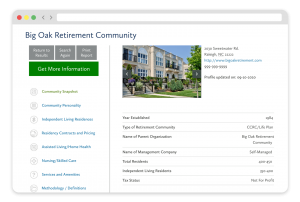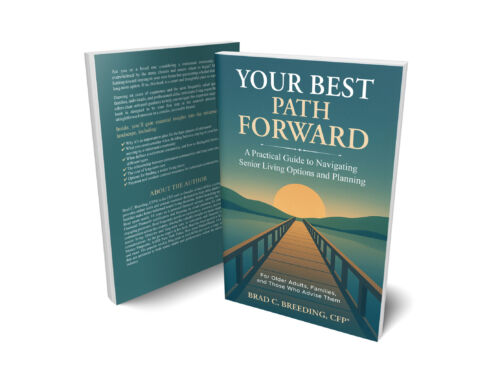Harvard professor and “happiness expert” Arthur Brooks, Ph.D., has suggested that every decade, it’s wise to shake up your life with meaningful change. For some people, that means a new career or hobby. But for older adults who are in or nearing retirement, one of the most powerful ways to embrace this “10-year rule” may be re-evaluating where you live and potentially moving.
If you’ve been in the same home for 20 years, 30 years, or even more, the thought of moving may feel overwhelming. Yet, research and other older adults’ experiences show that thoughtfully relocating or downsizing about every decade can bring renewed freedom, security, and joy in later life.
Still, for many of us, it is natural to resist change and to hold on to the past. For those in the later stages of life, these urges may feel even stronger- particularly if faced with moving to an assisted living community- because there is often the perception of giving up independence. Even those who do not require assistance are often reluctant to consider options such as a continuing care retirement community or other 55+ retirement community for the same reason.
However, if we train ourselves in our earlier years to adapt to the changes that come with moving every 10 years, and in the process, reduce the amount of clutter that tends to accumulate over time, then we may all be slightly less resistant to eventually making a senior living move that could be in the best interest of ourselves and our families.
A 10-year move’s practical benefits
The thought of moving every 10 years (or some other periodic frequency) may seem overwhelming, unnecessary … or some combination of the two. But there is logic in this philosophy.
For instance, consider all of your “stuff.” Staying in one place for too long can allow clutter — both physical and emotional — to build up. A move every 10 years provides a natural opportunity to reevaluate your surroundings, your belongings, and your lifestyle, and consider what you truly need versus what you can let go of.
For older adults, going through this assessment process often is tied to downsizing, which can have its own benefits. Selling a larger home can free up significant home equity, reduce living expenses, and eliminate the physical demands of maintaining a property that no longer suits your needs. According to Kiplinger, many retirees find that downsizing lowers or even eliminates their mortgage, while also reducing property taxes, utilities, insurance, and ongoing maintenance costs.
But the benefits of downsizing may go beyond finances. A smaller home can make daily life easier, with less upkeep and fewer chores consuming your time and energy. It can also mean a safer environment, especially if you transition into a one-level residence or a retirement community designed with accessibility in mind. Wide doorways, walk-in showers, and single-floor layouts are not luxuries for older adults; they are features that support your long-term independence as you age.
I’ll never forget when I first started myLifeSite and I visited a CCRC here locally to learn more. I spoke with some of the residents including one couple who had just recently moved in. When I asked how they felt about the move, the first thing the wife said to me was, “It’s a liberating feeling not having all that ‘stuff’ and the home to keep up with.” The word “liberating” always stuck with me.
>> Related: Memories, Meaning, and Moving On: A Compassionate Guide to Senior Downsizing
The emotional side of an every-decade move
Of course, the idea of moving every 10 years may not sound appealing at first, especially if you’ve lived in your home for many decades. The walls likely hold cherished memories, and the thought of leaving can stir up nostalgia or even grief.
It’s true that moving is one of the most stressful transitions some people face in life, according to research, up there with other major life events like the death of a loved one, divorce, or a major illness or injury. In fact, there is even a medical term for the physiological and psychological strain sometimes associated with moving: “transfer trauma” or relocation stress syndrome (RSS).
RSS is a set of behavior, mood, and physical symptoms that can impact a person when they move from one home to another. Although RSS can affect people of any age, including children, it is often most detrimental to the physical and psychological well-being of older adults. The impact can be compounded if the older person’s move is not their choice — perhaps having to relocate to a long-term care facility, for instance.
It’s important to know that there are ways to help prevent or reduce RSS and the other challenges that older adults can face with moving (particularly those moving to a senior living community). But RSS is arguably another persuasive reason that people should consider building a 10-year cycle of housing re-evaluation since proactive moves can make the relocation process more manageable, both mentally and physically.
Instead of waiting until a crisis such as a sudden health issue or the loss of a spouse forces you to move, consciously choosing to move every decade can help you stay in control of the decision. It allows you to sort through belongings gradually, downsize intentionally, and choose a home that reflects your current needs as well as your future plans.
>> Related: Grappling With The Finality of “The Last Move” to a Retirement Community
Trends that support the 10-year move strategy
There are a variety of compelling reasons older adults may want to consider adopting the 10-year move philosophy, and several recent trends support this decision.
First, such moves allow older adults to periodically move to better-suited residences. Research shows that older adults that make a move are significantly more likely than younger adults to downsize to a smaller home or move into homes that better match their evolving needs (such as homes with a first-floor master bedroom and bathroom). Statistically, retirees also tend to move to more desirable neighborhoods and move closer to the coast.
Next, while many Baby Boomers say they want to age in place, AARP surveys also reveal that 1 in 3 eventually do make the choice to relocate. Those who proactively move often seek out affordability, proximity to family, or lifestyle amenities, which can in turn be beneficial to older adults’ financial, physical, and emotional wellbeing.
Looking ahead, Gen X is likely to follow this pattern, with downsizing becoming an increasingly common way to fund and simplify retirement. It is important to note, however, that while selling a larger home can free up significant equity and bolster retirement savings, don’t assume you’ll turn a substantial profit. Market conditions and home updates can heavily impact your sale price and thus your return.
>> Related: Pre-Crisis vs. Post-Crisis Planning: Confronting Life’s Unknowns
A proactive move ensures you maintain control over your home
Each decade, nearly every older adult’s life circumstances evolve in some respect: young adult children leave home, health needs shift, community ties change. What worked at age 55 may begin to feel burdensome by 65, and what seemed manageable at 65 may no longer be ideal at 75.
This is why an every 10-year assessment of your housing situation (and a potential move) provides a practical framework for adjusting your living situation. As an added advantage, this every-decade analysis keeps you in sync with the five financial phases of retirement:
- Accumulation
- Pre-retirement
- Early retirement
- Mid-retirement
- Late retirement
Bear in mind that the idea of moving every 10 years isn’t about constant disruption; it’s about intentional renewal. For older adults, this might mean selling a long-time family home and moving into a smaller, safer, more affordable space. Or it might mean transitioning into a retirement community that offers social opportunities and built-in support, if it’s ever needed.
Either way, revisiting your living situation every decade ensures that your home continues to serve you, rather than the other way around. Instead of seeing a move as “starting over,” think of it as “right-sizing” your life for the decade ahead.
By embracing the 10-year rule, you can shed unnecessary burdens, unlock financial flexibility, and create a living environment that supports joy, security, and independence for years to come.
Originally posted July 15, 2015; updated Aug. 25, 2025

FREE Detailed Profile Reports on CCRCs/Life Plan Communities
Search Communities






